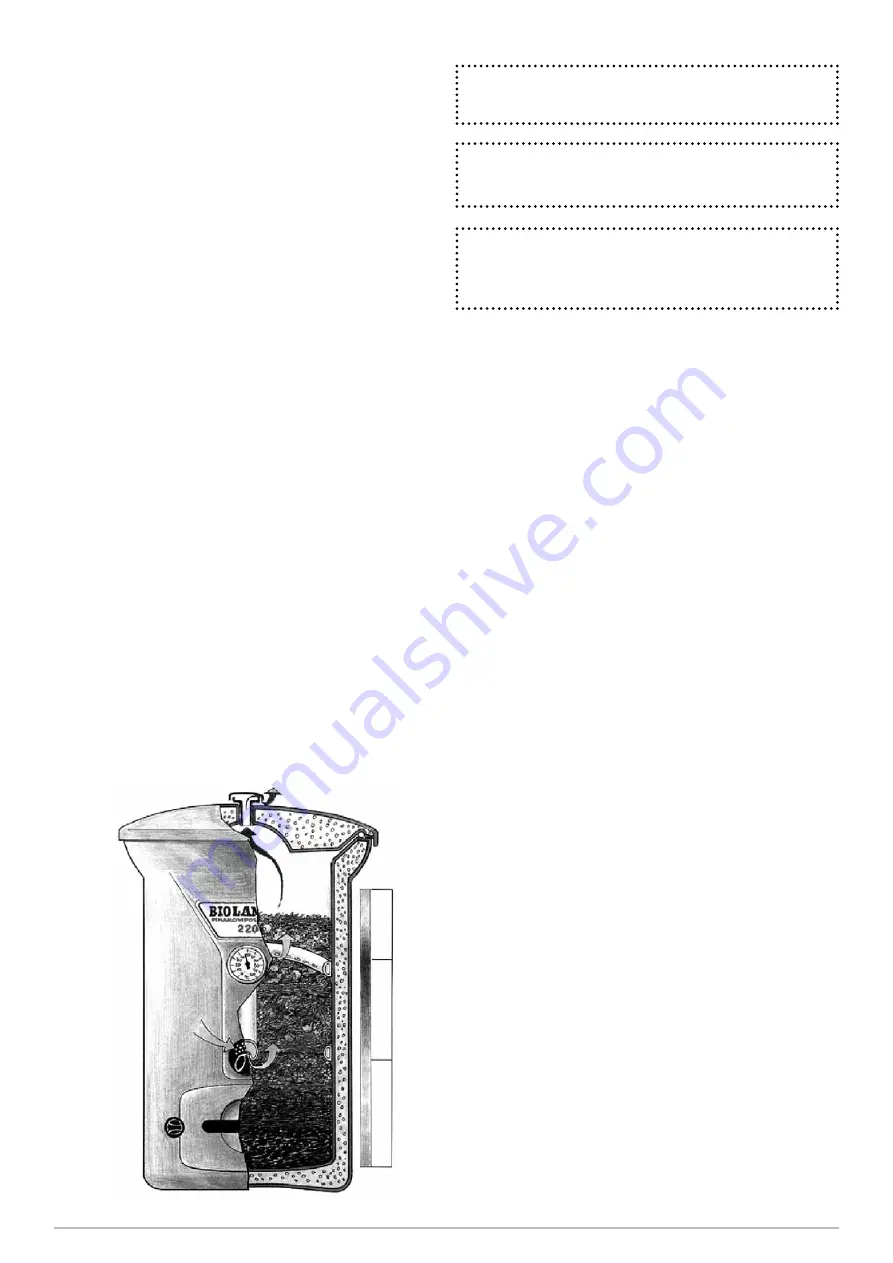
BIOLAN OY
-
6-
2.4 Emptying the Biolan Composter
Compost that has reached the cover soil stage is emptied from
the Biolan Composter. The waste matures to cover soil in about
5–8 weeks after the composting process has started. To enable
an efficient uninterrupted composting process, we recommend
that at most half of the mass be discharged from the unit at a
time.
1. Place the emptying tray under the front edge of the com-
poster.
2. Using the emptying bucket (part 29) or a straight-edged
spade, empty from the compost the part that has matured
the most.
3. Attach the emptying door and drop the remaining compost
mass onto the bottom of the composter using the mixer or
the spade.
3. What happens in the Biolan Composter?
The micro-organisms that decompose the compost use the waste in the
compost as well as each other for nut rition. Three stages can be sepa-
rated in composting: warming phase, hot phase and cooling phase.
The composting process does not start until the amount of waste is suf-
ficient and the population of micro-organisms has been created.
The heating-up stage
•
temperature 0–40°C
•
decomposing performed mostly by bacteria
•
sugars and proteins are the nutrients
•
lasts in general a few days
The hot stage
•
the temperature rises over 40°C
•
decomposing performed by bacteria and actinomycete, which spe-
cialize in high temperatures
•
micro-organisms of the hot phase and decomposing products are
used as nutrition
•
lasts from a few days to at most a few weeks
Cooling phase, i.e. the cover soil phase
•
temperature drops to the level of the surrounding environment
•
decomposing performed by fungi, actinomycete and earthworms
•
the most resilient parts of the compost are decomposed: e.g.
lignin and cellulose
•
humus is formed
•
lasts a long time, at least several months
The decomposing micro-organisms have three basic needs that have to be fulfilled in order to provide effective composting. oxygen,
humidity and nutrients.
OXYGEN: The micro-organisms need oxygen to survive. To ensure sufficient looseness, Biolan Compost and Toilet Bulking Material
(the litter specifically developed for the Biolan Composter) shall be mixed with waste. Applying suitable bulking material is essential
for proper operation of the composter. The Biolan Compost and Toilet Bulking Material brings
about looseness, binds excess moisture and neutralises odours. Branch chaff can also be
used for additional looseness. Sawdust, cutter chips, peat, tree leaves and grass are materi-
als which pack up and therefore they must not be used as bulking material.
HUMIDITY: The micro-organisms of the compost are swimmers, which can only live in a humid environment. The humidity of the com-
post mass is suitable when the mass glistens with moisture and, when clenched in the hand, a few drops of water can be extracted
from it.
NUTRIENTS: The carbon-nitrogen balance of the compost must be correct. Kitchen waste, green garden waste, manure and urine
are sources of nitrogen. Withered brown waste, such as ripened hay, straw, tree leaves and branches contain carbon. Also the Biolan
Compost and Toilet Bulking Material contains a lot of carbon.
Looseness
Moisture
Nutrition
If the composter smells
rotten, it is too tight and
lacks oxygen.
The micro-organisms decomposing the compost do not have
teeth. The larger the bits you place in the compost the longer
it takes for them to decompose.
The Biolan Composter can be emptied all year round. Empty-
ing often boosts the operation of the composter as a result of
the oxygen surge.
2.5 Cleaning the Biolan Composter
Various mould and ray fungi are the decomposers in the compost, and should not be washed away. The air valve (parts 11 and 12)
and the possible seep liquid hose (see paragraph 1) shall be cleaned as required, however, at least every five years.
The Biolan Compost and Toilet Bulking Material has been ex-
plicitly developed for the Biolan Composter. It is sufficiently
coarse and sour. The compost stays airy and the bark of co-
niferous trees repels flies.








